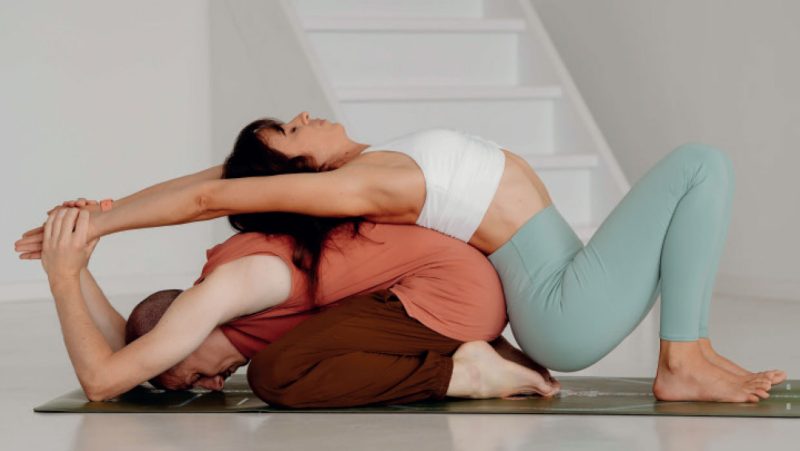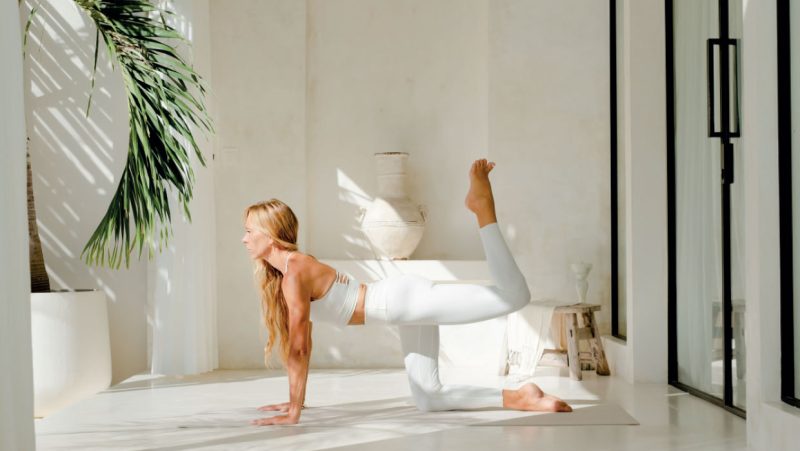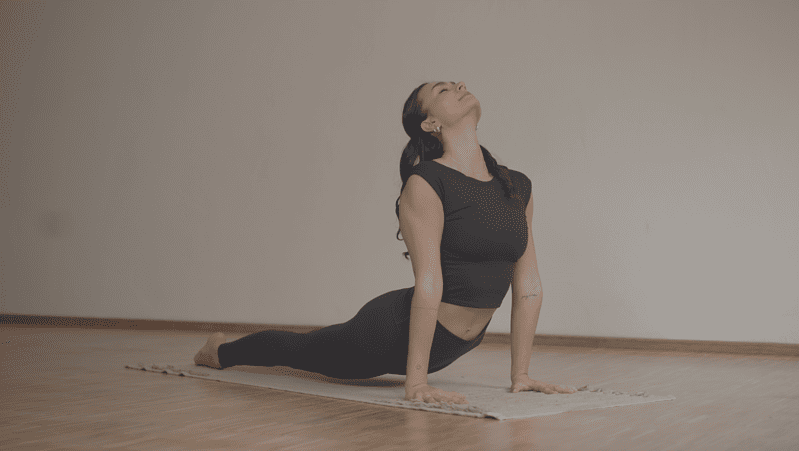
Clinical Yoga for Menopause
Discover How Tailored Yoga Practices Can Provide Holistic Relief and Enhance Well-Being During Menopause - By Magnolia Zuniga
Reading time: 5 minutes
Navigating menopause can be challenging, but yoga offers a holistic approach to manage its symptoms. By tailoring yoga practices to specific menopausal symptoms, women can find relief and enhance their well-being. Here’s how clinical yoga can help address common menopausal symptoms.
1. Hot Flashes
Yoga Sequence:
- Supported Bridge Pose (Setu Bandhasana): This cooling posture helps regulate body temperature and alleviate hot flashes.
- Instructions: Lie on your back with your knees bent and feet hip-width apart. Lift your hips and place a block under your sacrum. Hold for 5-10 breaths.
- Why It Works: Supported Bridge Pose activates the parasympathetic nervous system, reducing the body's stress response and managing hot flashes effectively.
- Legs Up the Wall (Viparita Karani): A restorative pose that cools the body and reduces stress.
- Instructions: Sit sideways against a wall and swing your legs up the wall as you lie back. Adjust your hips close to the wall and rest.
- Why It Works: This pose promotes venous return and relaxation, helping to lower core body temperature and alleviate hot flashes.
- Reclining Bound Angle Pose (Supta Baddha Konasana): Opens the hips and promotes relaxation.
- Instructions: Lie on your back with the soles of your feet together and knees apart. Place cushions under your knees for support and relax.
- Why It Works: Supporting the reproductive organs and stimulating the heart, this pose improves circulation and helps cool the body.
- Child's Pose (Balasana): Provides a calming and cooling effect on the body.
- Instructions: Kneel on the floor, sit back on your heels, and fold forward, resting your forehead on the mat. Extend your arms in front of you or rest them by your sides. Hold for 5-10 breaths.
- Why It Works: Calming the nervous system and reducing stress hormones, Child's Pose helps manage the frequency and intensity of hot flashes.
- Seated Forward Bend (Paschimottanasana): Stretches the spine and has a cooling effect.
- Instructions: Sit with your legs extended in front of you. Inhale and lengthen your spine, then exhale and fold forward, reaching for your feet. Hold for 5-10 breaths.
- Why It Works: This pose calms the mind and stretches the body, reducing the sensation of heat and tension associated with hot flashes.
Pranayama:
- Sheetali (Cooling Breath): This pranayama technique helps cool the body and calm the mind.
- Instructions: Sit comfortably, roll your tongue into a tube, and inhale through it. Close your mouth and exhale through your nose. Repeat for 5-10 breaths.
- Why It Works: Sheetali breathing reduces body temperature and produces a calming effect on the nervous system, beneficial for managing hot flashes.
- Chandra Bhedana (Left Nostril Breathing): This breathing technique cools the body and balances energy.
- Instructions: Sit comfortably, close your right nostril with your thumb, and inhale slowly through your left nostril. Close your left nostril with your ring finger and exhale through your right nostril. Repeat for 5-10 breaths.
- Why It Works: Activating the cooling energies of the body, Chandra Bhedana reduces sympathetic nervous system activity, helping alleviate hot flashes.
Meditation:
- Guided Visualization: Focus on calming imagery such as a cool breeze or a peaceful lake to reduce the intensity of hot flashes.
2. Brain Fog
Yoga Sequence:
- Sun Salutations (Surya Namaskar): Energizing postures that improve circulation and mental clarity.
- Instructions: Perform a series of Sun Salutations to invigorate the body and mind.
- Why It Works: Increasing blood flow to the brain and body, Sun Salutations enhance oxygen supply and improve cognitive function.
- Warrior II (Virabhadrasana II): Enhances focus and strength.
- Instructions: From a standing position, step your feet wide apart. Turn your right foot out, bend your right knee, and extend your arms parallel to the floor. Hold for 5-10 breaths and switch sides.
- Why It Works: Engaging large muscle groups and promoting mental focus, Warrior II helps clear brain fog.
- Triangle Pose (Trikonasana): Increases concentration and balance.
- Instructions: Stand with your feet wide apart. Turn your right foot out and your left foot slightly in. Extend your arms out to the sides and bend at the hip to reach your right hand toward your right foot, left arm pointing up. Hold for 5-10 breaths and switch sides.
- Why It Works: Improving balance and coordination, Triangle Pose enhances mental clarity.
- Camel Pose (Ustrasana): Opens the chest and improves blood flow to the brain.
- Instructions: Kneel on the floor with your knees hip-width apart. Place your hands on your lower back and gently arch backward, reaching for your heels. Hold for 5-10 breaths.
- Why It Works: By opening the thoracic region, Camel Pose improves lung capacity and increases brain oxygenation, reducing brain fog.
Pranayama:
- Nadi Shodhana (Alternate Nostril Breathing): Balances the hemispheres of the brain and improves mental clarity.
- Instructions: Sit comfortably, close your right nostril with your thumb, and inhale through your left nostril. Close your left nostril with your ring finger, open your right nostril, and exhale. Repeat on the other side. Continue for 5-10 cycles.
- Why It Works: Balancing the nervous system and increasing oxygen flow to both brain hemispheres, this practice aids cognitive function.
- Kapalabhati (Skull Shining Breath): Increases oxygen supply to the brain and boosts mental clarity.
- Instructions: Sit comfortably, inhale deeply, and exhale sharply through your nose by contracting your abdominal muscles. Repeat 20-30 times, then take a deep breath and relax.
- Why It Works: Stimulating the brain and clearing nasal passages, Kapalabhati enhances mental clarity and reduces brain fog.
Meditation:
- Mindfulness Meditation: Focus on the present moment to enhance concentration and awareness.
- Instructions: Sit comfortably and bring your attention to your breath. Notice each inhale and exhale, gently bringing your mind back to your breath when it wanders.
- Why It Works: Mindfulness Meditation increases grey matter density in the brain, improving attention and cognitive function.
3. Joint and Muscle Pain
Yoga Sequence:
- Child’s Pose (Balasana): Relieves tension in the back and hips.
- Instructions: Kneel on the floor, sit back on your heels, and fold forward, resting your forehead on the mat. Extend your arms in front of you or rest them by your sides. Hold for 5-10 breaths.
- Why It Works: Gently stretching the lower back and hips, Child's Pose reduces muscle tension and promotes relaxation.
- Reclining Bound Angle Pose (Supta Baddha Konasana): Opens the hips and promotes relaxation.
- Instructions: Lie on your back, bring the soles of your feet together, and let your knees fall open. Place cushions under your knees for support and relax.
- Why It Works: Improving circulation to the pelvic region, this pose relaxes muscles and alleviates joint and muscle pain.
- Cat-Cow Pose (Marjaryasana-Bitilasana): Increases flexibility and releases tension in the spine and hips.
- Instructions: Start on your hands and knees. Inhale, arch your back (Cow Pose), and exhale, round your spine (Cat Pose). Repeat for 10-15 breaths.
- Why It Works: The rhythmic movement of Cat-Cow Pose increases spinal flexibility and reduces joint stiffness, helping alleviate pain.
- Pigeon Pose (Eka Pada Rajakapotasana): Stretches the hip flexors and relieves lower back tension.
- Instructions: From Downward-Facing Dog, bring your right knee forward and place it behind your right wrist. Extend your left leg back and lower your hips toward the floor. Hold for 5-10 breaths and switch sides.
- Why It Works: Deeply stretching the hip flexors and piriformis muscle, Pigeon Pose reduces tension and pain in the lower back and hips.
- Supine Twist (Supta Matsyendrasana): Relieves tension in the spine and hips.
- Instructions: Lie on your back, bring your knees to your chest, and drop them to one side while extending your arms out to the sides. Hold for 5-10 breaths and switch sides.
- Why It Works: Gently stretching the spine, Supine Twist relieves lower back and hip tension, promoting relaxation and pain relief.
Pranayama:
- Deep Diaphragmatic Breathing: Promotes relaxation and pain relief.
- Instructions: Sit or lie down comfortably. Place one hand on your chest and the other on your abdomen. Inhale deeply through your nose, allowing your abdomen to rise, then exhale slowly through your mouth. Repeat for 5-10 breaths.
- Why It Works: Stimulating the vagus nerve, diaphragmatic breathing promotes relaxation and reduces pain perception.
- Bhramari (Bee Breath): Calms the mind and helps reduce pain perception.
- Instructions: Sit comfortably, close your eyes, and cover your ears with your thumbs. Place your index fingers on your forehead and the remaining fingers over your eyes. Inhale deeply and as you exhale, make a humming sound like a bee. Repeat for 5-10 breaths.
- Why It Works: The vibrations produced by Bhramari stimulate the parasympathetic nervous system, reducing stress and pain perception.
Meditation:
- Body Scan Meditation: Increases awareness of physical sensations and promotes relaxation.
- Instructions: Lie down comfortably and close your eyes. Slowly bring your attention to each part of your body, starting from your toes and moving up to your head. Notice any sensations without judgment and relax each area as you go.
- Why It Works: Body Scan Meditation increases mindfulness of physical sensations, reducing pain perception and promoting relaxation.
4. Irritability
Yoga Sequence:
- Tree Pose (Vrksasana): Grounding posture that calms the mind.
- Instructions: Stand on one leg, place the sole of the opposite foot on your inner thigh or calf, and bring your hands to prayer position. Hold for 5-10 breaths and switch sides.
- Why It Works: Tree Pose enhances balance and focus, promoting a sense of grounding and calm, which helps reduce irritability.
- Forward Fold (Uttanasana): Soothes the nervous system and reduces stress.
- Instructions: Stand with your feet hip-width apart, hinge at your hips, and fold forward, letting your head hang. Hold for 5-10 breaths.
- Why It Works: Forward Fold calms the nervous system by stimulating the parasympathetic response, reducing stress and irritability.
- Child's Pose (Balasana): Provides a calming effect and reduces irritability.
- Instructions: Kneel on the floor, sit back on your heels, and fold forward, resting your forehead on the mat. Extend your arms in front of you or rest them by your sides. Hold for 5-10 breaths.
- Why It Works: Child's Pose calms the nervous system and reduces cortisol levels, helping to manage irritability.
- Seated Forward Bend (Paschimottanasana): Helps calm the mind and relieve tension.
- Instructions: Sit with your legs extended in front of you. Inhale and lengthen your spine, then exhale and fold forward, reaching for your feet. Hold for 5-10 breaths.
- Why It Works: Seated Forward Bend stretches the spine and hamstrings, promoting relaxation and reducing mental stress.
Pranayama:
- Bhramari (Bee Breath): Reduces stress and induces calm.
- Instructions: Sit comfortably, close your eyes, and cover your ears with your thumbs. Place your index fingers on your forehead and the remaining fingers over your eyes. Inhale deeply and as you exhale, make a humming sound like a bee. Repeat for 5-10 breaths.
- Why It Works: Bhramari breathing stimulates the parasympathetic nervous system, reducing stress hormones and inducing a calming effect.
- Sheetkari (Hissing Breath): Cools the body and calms the mind.
- Instructions: Sit comfortably and clench your teeth together, with your lips slightly open. Inhale slowly through the gaps in your teeth, producing a hissing sound. Close your mouth and exhale slowly through your nose. Repeat for 5-10 breaths.
- Why It Works: Sheetkari breathing has a cooling effect on the body and mind, reducing the physiological response to stress and irritability.
Meditation:
- Loving-Kindness Meditation (Metta): Fosters compassion and emotional balance.
- Instructions: Sit comfortably and close your eyes. Silently repeat the phrases: "May I be happy, may I be healthy, may I be safe, may I live with ease." Gradually extend these wishes to others in your life.
- Why It Works: Loving-Kindness Meditation increases positive emotions and emotional resilience, reducing feelings of irritability and enhancing overall well-being.
By integrating these tailored yoga practices into your daily routine, you can manage the various symptoms of menopause more effectively. Remember, consistency and listening to your body's needs are key to achieving the best results. For further guidance and personalized practices, consider consulting with a certified yoga instructor or Ayurvedic practitioner who specializes in menopausal health.





